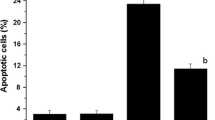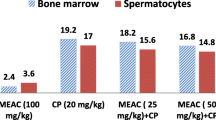Abstract
Brazilin and brazilein, the major compounds of Caesalpinia sappan L. (CS) have been reported to possess antioxidant and cytotoxic activities and could potentially be used as an antigenotoxic as well as an anticancer. This study was conducted to investigate the cytotoxic and antigenotoxic effects of CS ethanolic extract (CEE). In vivo mammalian micronucleus test of CEE at the dose of 500 mg/kg BW and 1000 mg/kg BW decreased the number of MNPCE and increased the ratio of PCE to NCE meaning that CEE performed antigenotoxic effect in an in vivo model. In contrast, CEE and doxorubicin (DOXO) performed cytotoxic effect on CHO-K1 cells under MTT assay with IC50 values of 67 μg/mL and 6 μM, respectively. Interestingly, treatment of CEE in combination with DOXO and H2O2 as genotoxic inducer decreased intracellular ROS levels. In addition, in vitro genotoxicity study by using cytokinesis-block micronucleus (CBMN) assay, both of Giemsa staining and flow cytometric analysis showed that the treatment of CEE increased the number of micronuclei and correlated with apoptotic induction results. Moreover, the combination of CEE and DOXO induced cells accumulation in Sub-G1 and G2/M phase. In conclusion, CEE performed antigenotoxic effect in an in vivo model and cytotoxic effect on CHO-K1 cells.




Similar content being viewed by others
References
Avlasevich S, Bryce S et al (2011) Flow cytometric analysis of micronuclei in mammalian cell cultures: past, present and future. Mutagenesis 26(1):147–152
Badami S, Moorkoth S, Rai SR et al (2003) Antioxidant activity of Caesalpinia sappan heartwood. Biol Pharm Bull 26(11):1534–1537
Batubara I, Mitsunaga T, Ohashi H (2009) Screening antiacne potency of Indonesian medicinal plants: antibacterial, lipase inhibition, and antioxidant activities. J Wood Sci 55(3):230–235
Batubara I, Mitsunaga T, Ohashi H (2010) Brazilin from Caesalpinia sappan wood as an antiacne agent. J Wood Sci 56(1):77–81
Bryce SM, Shi J, Nicolette J, Diehl M, Sonders P, Avlasevich S et al (2010) High content flow cytometric micronucleus scoring method is applicable to attachment cell lines. Environ Mol Mutagen 51(3):260–266
Crook TR, Souhami RL, McLean AE (1986) Cytotoxicity, DNA cross-linking, and single strand breaks induced by activated cyclophosphamide and acrolein in human leukemia cells. Cancer Res 46(10):5029–5034
Deavall DG, Martin EA, Horner JM, Roberts R (2012) Drug-induced oxidative stress and toxicity. J Toxicol. https://doi.org/10.1155/2012/645460
Do QD, Angkawijaya AE, Tran-Nguyen PL, Huynh LH, Soetaredjo FE, Ismadji S, Ju YH (2014) Effect of extraction solvent on total phenol content total flavonoid content and antioxidant activity of Limnophila aromatic. J Food Drug Anal 22:296–302
Fenech M (2000) The in vitro micronucleus technique. Mutat Res 455(1–2):81–95
Gao S, Chen T, Choi MY, Liang Y, Xue J et al (2013) Cyanidin reverses cisplatin-induced apoptosis in HK-2 proximal tubular cells through inhibition of ROS-mediated DNA damage and modulation of the ERK and AKT pathways. Cancer Lett 333:36–46
Gray JW, Collins C (2000) Genome changes and gene expression in human solid tumors. Carcinogenesis 21(3):443–452
Handayani S, Susidarti RA, Udin Z, Meiyanto E, Jenie RI (2016) Brazilein in Combination with cisplatin inhibit proliferation and migration on highly metastatic cancer cells, 4T1. Indones J Biotechnol 21:38–47
Haryanti S, Pramono S, Murwanti R, Meiyanto E (2016) The synergistic effect of doxorubicin and ethanolic extracts of Caesalpinia sappan L. wood and Ficus septica Burm. F. leaves on viability, cell cycle progression, and apoptosis induction of MCF-7 cells. Indones J Biotechnol 21:29–37
Haryanti S, Murwanti R, Puti H, Ilmawati GP, Pramono S, Meiyanto E (2017) Different 4T1 cells migration under Caesalpinia sappan L. and Ficus septica Burm. F ethanolic extracts. Indones J Cancer Chemoprev 8(1):21–26
Ho PC, Saville DJ, Wanwimolruk S (2001) Inhibition of human CYP3A4 activity by grapefruit flavonoids, furanocoumarins and related compounds. J Pharm Pharm Sci 4:217–227
Hung TM, Dang NH, Dat NT (2014) Methanol extract from Vietnamese Caesalpinia sappan induces apoptosis in HeLa cells. Biol Res 47:1–5
Khamsita R, Hermawan A, Putri DDP, Meiyanto E (2012) Ethanolic extract of Secang (Caesalpinia sappan L.) wood performs as chemosensitizing agent through apoptotic induction on breast cancer MCF-7 Cells. Indones J Cancer Chemoprev 3(3):444–449
Kirsch-Volders M, Sofuni T, Aardema M, Albertini S, Eastmond D, Fenech M et al (2003) Report from the in vitro micronucleus assay working group. Mutat Res 540(2):153–163
Krishna G, Hayashi M (2000) In vivo rodent micronucleus assay: protocol, conduct and data interpretation. Mutat Res 455:155–166
Lim D-K, Choi U, Shin D-H (1996) Antioxidative activity of some solvent extract from Caesalpinia sappan L. Korean J Food Sci Technol 28(1):77–82
Lobo V, Phatak A, Chandra N (2010) Free radicals and functional foods: impact on human health. Pharmacogn Rev 4:118–126
Menoli RCRN, Mantovani MS, Ribeiro LR, Speit G, Jordão BQ (2001) Antimutagenic effects of the mushroom Agaricus blazei Murrill extracts on V79 cells. Mutat Res Toxicol Environ Mutagen 496(1–2):5–13
Nirmal NP, Panichayupakaranant P (2015) Antioxidant, antibacterial, and antiinflammatory activities of standardized brazilin-rich Caesalpinia sappan extract. Pharm Biol 53:1339–1343
Nurzijah I, Putri DDP, Rivanti E, Meiyanto E (2012) Secang (Caesalpinia sappan L.) heartwood ethanolic extract shows activity as doxorubicin cochemotherapeutic agent by apoptotis induction on T47D breast cancer cells. Indones J Cancer Chemoprev 3:377–384
Palasuwan A, Soogarun S, Lertlum T et al (2005) Inhibition of Heinz body induction in an in vitro model and total antioxidant activity of medicinal Thai plants. Asian Pac J Cancer Prev 6(4):458–463
Phelps JB, Garriott ML, Hoffman WP (2002) A protocol for the in vitro micronucleus test. II. Contributions to the validation of a protocol suitable for regulatory submissions from an examination of 10 chemicals with different mechanisms of action and different levels of activity. Mutat Res 521(1–2):103–112
Prayong P, Barusrux S, Weerapreeyakul N (2008) Cytotoxic activity screening of some indigenous Thai plants. Fitoterapia 79:598–601
Rachmady R, Muntafiah L, Rosyadi F, Sholihah I, Handayani S, Jenie RI (2016) Antiproliferative effect of Secang heartwood ethanolic extract (Caesalpinia sappan L.) on HER2-positive breast cancer cells. Indones J Cancer Chemoprev 7(1):1–5
Rao R, Shammo JM, Enschede SH (2005) The combination of fludarabine, cyclophosphamide, and granulocyte-macrophage colony-stimulating factor in the treatment of patients with relapsed chronic lymphocytic leukemia and low-grade non-Hodgkin’s lymphoma. Clin Lymphoma 6(1):26–30
Rehman MU, Tahir M, Ali F et al (2012) Cyclophosphamide-induced nephrotoxicity, genotoxicity, and damage in kidney genomic DNA of Swiss albino mice: the protective effect of ellagic acid. Mol Cell Biochem 65:119–127
Sakihama Y, Cohen MF, Grace SC, Yamasaki H (2002) Plant phenolic antioxidant and prooxidant activities: phenolics-induced oxidative damage mediated by metals in plants. Toxicology 177:67–80
Siess MH, Le Bon AM, Canivenc-Lavier MC, Suschetet M (2000) Mechanisms involved in the chemoprevention of flavonoids. BioFactors 12:193–199
Thomas PB, Risinger KE, Klinge CM (2003) Identification of estrogen receptor beta expression in Chinese hamster ovary (CHO) cells and comparison of estrogen-responsive gene transcription in cells adapted to serum-free media. J Steroid Biochem Mol Biol 86:41–55
Toegel S, Wu SQ, Otero M, Goldring MB, Leelapornpisid P, Chiari C et al (2012) Caesalpinina sappan extract inhibits IL 1β-mediated overexpression of matrix metalloproteinases in human chondrocytes. Genes Nutr 7(2):307–318
Tripathi DN, Jena GB (2009) Intervention of astaxanthin against cyclophosphamide-induced oxidative stress and DNA damage: a study in mice. Chem Biol Interact 180(3):398–406
Wang YZ, Sun S, Zhou Y (2011) Extract of the dried heartwood of Caesalpinia sappan L. attenuates collagen-induced arthritis. J Ethnopharmacol 136:271–278
You EJ, Khil LY, Kwak WJ, Won HS, Chae SH, Lee BH, Moon CK (2005) Effects of brazilin on the production of fructose-2,6-bisphosphate in rat hepatocytes. J Ethnopharmacol 102:53–57
Acknowledgements
This study was financially supported by Research Grant from The Ministry of Research, Technology, and Higher Education of the Republic of Indonesia. We would like to especially thank Prof. Masashi Kawaichi, Laboratory of Gene Function in Animal, Graduate School of Biological Science, Nara Institute of Science and Technology (NAIST) for providing the cell culture.
Author information
Authors and Affiliations
Corresponding author
Ethics declarations
Conflict of interest
The authors declare that they have no conflict of interest.
Statement on the welfare of animals
All procedures performed in studies involving animals were in accordance with the ethical standards from Universitas Gadjah Mada with the approval number 462/KEC-LPPT/IV/2016 at which the studies were conducted.
Rights and permissions
About this article
Cite this article
Meiyanto, E., Lestari, B., Sugiyanto, R.N. et al. Caesalpinia sappan L. heartwood ethanolic extract exerts genotoxic inhibitory and cytotoxic effects. Orient Pharm Exp Med 19, 27–36 (2019). https://doi.org/10.1007/s13596-018-0351-9
Received:
Accepted:
Published:
Issue Date:
DOI: https://doi.org/10.1007/s13596-018-0351-9




